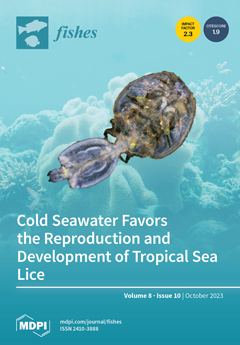Pheromones play a vital role in regulating fish behavior, including reproduction, aggregation, hazard recognition and food location. To gain a better understanding of chemical communication in fish produced by density changes, this study analyzed the metabolites released by turbot (
Scophthalmus maximus)
[...] Read more.
Pheromones play a vital role in regulating fish behavior, including reproduction, aggregation, hazard recognition and food location. To gain a better understanding of chemical communication in fish produced by density changes, this study analyzed the metabolites released by turbot (
Scophthalmus maximus) under different stocking densities. The experiment was conducted at low (LD: 3.01 kg/m
2), medium (MD: 6.62 kg/m
2) and high (HD: 10.84 kg/m
2) densities for 15 days. High-throughput non-targeted metabolomics (LC-MS/MS) was used to identify variations in metabolites released into the aquatic environment by turbot at different densities. Results showed that 29 and 47 metabolites were significantly upregulated in the MD and HD groups, respectively, compared with the LD group. Among them, hexadecanedioic acid, xanthine, phenethylamine, proline and styrene were significantly upregulated in the MD vs. LD, HD vs. MD and HD vs. LD. The VIP diagram of OPLS-DA alignment showed that phenethylamine was the most important metabolite shared by MD vs. LD, HD vs. MD and HD vs. LD. Key gene changes in the GH/IGF-1 signaling pathway, HPI axis of turbot were studied using qRT-PCR for density treatment. The results demonstrated that the expression of GH, GHR and IGF-1 was significantly lower, while the expression of CRH and ACTH was higher in the HD group. Additionally, plasma levels of cortisol, glucose, triglycerides and T
3 were also highest in the HD group compared with the LD and MD groups. Phenylethylamine concentration was positively correlated with the HPI axis and negatively correlated with the GH/IGF-1 signaling pathway. To investigate the impact of phenethylamine accumulation on turbot, an acute treatment experiment with phenethylamine was set up. Its concentration in the aquatic environment was set at 0 (CON), 10
−7 (LP) and 10
−5 (HP) mol/L via exogenous addition, and turbot were exposed to these environments for 2 days. There was a high degree of concordance between the GH/IGF-1 signaling pathway (GH, GHR, IGF-1), HPI axis (CRH, ACTH) and plasma physiological changes (cortisol, glucose, triglycerides, T
3) in the phenethylamine-treated group and the density-treated group. Therefore, accumulation of phenethylamine with increasing stocking density may be a potential cause of density stress. Phenylethylamine has a dose-dependent and trace effect as a pheromone.
Full article





